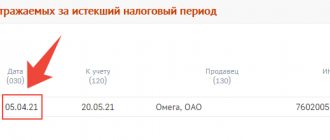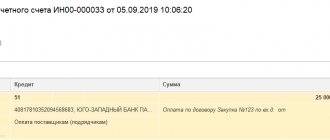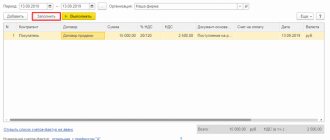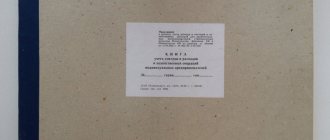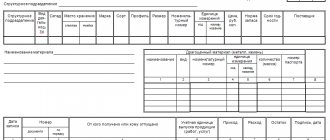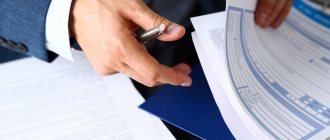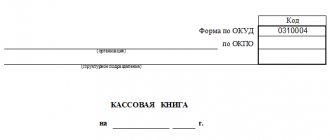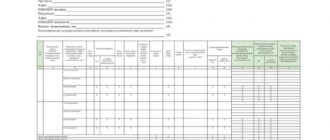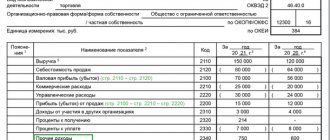The purchase ledger collects information about invoices received from sellers. Reflection of the received document in the book is carried out using registration records, which are sequentially entered into the tabular section as the document is received. Keeping a book is mandatory for persons recognized as VAT payers. Subsequently, information from this journal is used to generate the 8th section of quarterly tax reporting on added tax. In this article we will look at the purchase book form, provide a sample and instructions for filling it out.
Section 8. Information from the purchase book on transactions reflected for the expired tax period
- FAQ
Section 8 of the declaration is filled out by organizations and individual entrepreneurs (including tax agents) in cases where the right to tax deductions for the past tax period arises. An exception is made for tax agents authorized to sell confiscated, ownerless and other similar property, as well as those carrying out business activities involving participation in settlements based on agency agreements, commission agreements or agency agreements with foreign persons who are not registered with the tax authorities as taxpayers.
When submitting an updated declaration to the tax authority, the “Adjustment” field must be filled in . Previously submitted information" . “no correction required” sign is selected if the previously submitted information in this section is reflected correctly and does not require correction. “needs to be corrected” sign is indicated if the previously submitted information was reflected with errors or was not provided at all.
Next in the section you need to fill in information for each invoice registered in the purchase book, namely, indicate the transaction code, number and date of the seller’s invoice, INN and KPP of the seller, the date of registration of goods (work, services), the cost of purchases this invoice (including VAT) and the amount of VAT on the invoice.
In relation to traceable goods, the following must be indicated: the registration number of the batch of the traceable product, the code of the quantitative unit of measurement of the product in accordance with OKEI, the quantity and cost of such goods.
This section also provides for the reflection of such additional information as: number and date of correction of the seller's invoice, number and date of the seller's adjustment invoice, number and date of correction of the adjustment invoice, number of the customs declaration, currency code in accordance with the all-Russian classifier currencies, as well as the number and date of the payment document confirming the advance payment.
The total amounts of the cost of purchases and tax according to the purchase book are calculated in section 8 automatically.
Procedure for filling out the purchase book
Basic rules for working with a purchase book:
- fill out the purchase book in a way convenient for you - on paper or electronically;
- indicate cost indicators in rubles and kopecks (with the exception of column 14, filled in when purchasing goods and services or property rights for foreign currency);
- to correct incorrect entries in the purchase ledger, register or cancel the corrected invoice in the additional list of the purchase ledger in the same quarter when the first invoice was received;
- at the end of each quarter (no later than the 25th day of the month following the end of the quarter), sign the paper version of the purchase book from the manager (or an authorized person), lace and number the pages, seal them (if any);
- Keep sales books for at least 4 years from the date of last entry.
Find out what to consider when filling out an invoice from the materials in this section of our website.
What transaction codes can be indicated in section 8 of the VAT return?
In order to correctly indicate transaction codes in sections 8-11 of the declaration, the tax authorities prepared Examples of reflecting entries on invoices in the purchase book and sales book, indicating the CVO.
In accordance with these Examples and letters from the Federal Tax Service (dated 01/16/2018 No. SD-4-3/ [email protected] , dated 01/09/2018 No. SD-4-3/ [email protected] ), the following transaction codes can be indicated in section 8:
| No. | Operation type code | Name of the type of operation |
| 1 | 01 | Shipment (purchase) of goods (works, services) |
| 2 | 02 | Receiving (transferring) advance payments |
| 3 | 06 | Operations performed by tax agents (Article 161 of the Tax Code) |
| 4 | 13 | Contracting work for capital construction |
| 5 | 15 | Registration by the intermediary of his own goods and the goods of the consignor in one invoice |
| 6 | 16 | Return of goods from a buyer who does not pay VAT |
| 7 | 17 | Return of goods from a buyer - an individual |
| 8 | 18 | Adjustment of sales of goods (works, services) downwards |
| 9 | 19 | Import of goods from the EAEU |
| 10 | 20 | Import of goods from countries other than the EAEU |
| 11 | 22 | Deduction of VAT from a previously received advance or upon return of an advance |
| 12 | 23 | Purchase of services issued by BSO (clause 7 of Article 171 of the Tax Code) |
| 13 | 24 | VAT deduction on export transactions (paragraph 2, paragraph 9, article 165, paragraph 10, article 171 of the Tax Code) |
| 14 | 25 | Reinstatement of VAT when using goods in transactions taxed at 0% |
| 15 | 26 | Sale of goods (receipt of advances) to buyers who do not pay VAT, incl. individuals |
| 16 | 27 | Preparation by an intermediary of a consolidated invoice for the sale (purchase) of goods |
| 17 | 28 | Preparation by an intermediary of a consolidated invoice for the advance payment |
| 18 | 32 | Acceptance for deduction of VAT on goods imported into the territory of the Kaliningrad SEZ (clause 14 of Article 171 of the Tax Code) |
| 19 | 34 | Downward adjustment of the cost of shipments of raw hides and scrap |
| 20 | 36 | Deduction of VAT on goods for which compensation was paid to a foreigner (tax free system) |
| 21 | 41 | Deduction of VAT when transferring an advance payment for the supply of raw hides and scrap (“as for the buyer”) |
| 22 | 42 | VAT deduction on shipment of raw hides and scrap (“as per buyer”), incl. with increasing shipping costs |
| 23 | 43 | Deduction of VAT on advance payment after shipment of raw hides and scrap (“as for the seller”) |
| 24 | 44 | VAT deduction when reducing the cost of shipments of raw hides and scrap (“as for the seller”) |
What goes into the shopping book
The purchase book records:
- Invoices, including:
- received from sellers (clause 2 of the rules for maintaining a purchase book, approved by Resolution 1137; hereinafter referred to as the Rules for maintaining a purchase book);
- advance invoices for the shipment of goods, works, services (GWS) (clause 22 of the Rules for maintaining the purchase ledger), see the material “ Acceptance for deduction of VAT on advances received ” ;
- adjustment invoices to reduce the cost of shipment from the seller and increase it from the buyer (clauses 9 and 12 of the Rules for maintaining the purchase ledger), see the material “ What is an adjustment invoice and when is it needed? " ;
- for construction and installation works for own consumption, when deducting VAT on them (clause 20 of the Rules for maintaining a purchase ledger).
- Other documents that, along with invoices, serve as the basis for deducting VAT, for example:
- strict reporting forms or copies thereof - when deducting travel expenses (clause 18 of the Rules for maintaining a purchase ledger);
- customs declaration and payment documents confirming payment of import VAT - upon import (clause 6 of the Rules for maintaining a purchase book);
- statements on the import of goods and payment of indirect taxes - when importing goods from the EAEU (clause 6 of the Rules for maintaining a purchase book), etc.
Entries in the purchase book are made as the right to tax deductions arises.
See the material “ What are VAT tax deductions? " .
In this case, invoices are registered in a unified manner (clause 2 of the Rules for maintaining a purchase ledger):
- regular, corrective and corrected;
- received on paper and electronically;
- filled out partly using a computer, partly by hand.
The procedure for filling out an updated declaration
The updated declaration is filled out in the same form as the primary one. This declaration includes:
- all sections that were present in the previously submitted declaration (even if there were no errors in them);
- additional sections in which you need to reflect data not specified in the primary declaration.
To create an updated declaration you need:
- on the title page in the “Adjustment number” , indicate the serial number of the updated declaration;
- in the “Adjustment” field. Previously submitted information” select the indicator of the relevance of previously submitted information.
“no correction required” sign is indicated if the previously submitted section information is reflected correctly and does not require correction. In this case, such a section is not sent again as part of the updated declaration.
“needs to be corrected” sign is indicated if previously submitted information was reflected with errors or was not provided at all. In this case, this section with the changes made to it is re-sent as part of the updated declaration. To create and fill out a section that was not in the primary declaration, this attribute is also selected.
Instructions for filling out the book
Before making entries in the book, you must familiarize yourself with the contents of the Rules approved by government decree No. 1137. Filling out the columns of the purchase book:
| Column number | Explanations for filling |
| 1 | Sequential numbering of table rows with registration records. |
| 2 | The transaction code is taken from the List attached to the order of the Federal Tax Service MMV [email protected] dated 03/14/16. Codes can be specified separated by commas if the registered s/f simultaneously reflects several operations. |
| 3 | No., day, month, year indicated in the registered document (from column 1 of the s/f). |
| 4 | The number and date are filled in if a corrected s/f is subject to registration, that is, data is transferred from line 1a to s/f. |
| 5 | The number and date of the adjustment type s/f is entered - an independent document drawn up in addition to the original one. |
| 6 | The number and date of the corrected s/f correction type are indicated. |
| 7 | Details of the payment document are filled in if the moment of tax payment precedes the acceptance of this tax for deduction:
|
| 8 | The day on which the valuables, services, and work specified in the s/f are capitalized. |
| 9-10 | Seller details from fields 2 and 2b s/f. |
| 11-12 | Details of the intermediary, if the tax account is drawn up when the company performs the functions of a tax agent. |
| 13 | No. of the customs declaration, if customs declaration is required for valuables imported into the Russian Federation. For adjustment (including corrected adjustment) s/f column you do not need to fill out. |
| 14 | The code and name of the currency are entered if the amounts in the account are expressed in foreign currency. If the amounts are in Russian rubles, the column is not filled in. |
| 15 | The total cost of the s/f, including VAT, from column 9 in the “total” line of the registered s/f. If an advance payment is registered, then the total amount of the advance including VAT is entered. |
| 16 | The total VAT on s/f, which the company has the right to deduct, is taken from column 8 of s/f in the “Total” page. |
Example of filling out a purchase book:
How to fill out an updated declaration if there is an error in the invoice details?
If errors are discovered as a result of which VAT was not underestimated, it is not necessary to submit an updated declaration. Errors in the invoice details (incorrect number and (or) date) do not affect the calculation of the tax base and the amount of deductions, so an updated declaration does not need to be submitted. If the tax authority in this case asks for clarification, then it is necessary to respond to the request by indicating the correct data.
However, the taxpayer can voluntarily, without waiting for the Federal Tax Service's request, submit an updated declaration.
In this case, you can use different options for clarifying the data in the declaration. The most common are the following:
- 1) when filling out an updated declaration, in the section in which the invoice with incorrect details is indicated, it is necessary to indicate the relevance. To do this, in the “Adjustment” field. Previously submitted information”, select the “requires correction” and indicate the correct invoice details;
- 2) the section of the declaration in which the invoice with incorrect details was indicated remains unchanged, for which purpose in the “Adjustment” field. Previously submitted information”, “does not need to be corrected” attribute is selected (as if everything there is correct). But in this case, it is necessary to fill out Appendix 1 to Section 8 or 9, first reflecting in it the data on the invoice, during the registration of which an error was made, with a negative value, and then register the same invoice correctly. If Annex 1 was previously included in the updated declaration, it should have the “needs to be corrected” .
For example, Master Plus LLC, in its initial declaration for the 2nd quarter of 2021, incorrectly indicated the date of invoice No. 201 received from Omega OJSC.
Having discovered the error before the tax authorities and without waiting for a request from the Federal Tax Service, Master Plus LLC decided to submit an updated declaration. In this case, you can make corrections using the first option:
- open the submitted primary declaration and indicate “1” “Adjustment number”
- sections that contain no errors should be left unchanged;
- in section 8, in which the incorrect invoice was indicated, indicate the relevance indicator “needs correction” and the correct date of the invoice. Leave everything else in the section unchanged.
You can also correct the data using the second option:
- open the submitted primary declaration and indicate “1” “Adjustment number”
- sections that contain no errors should be left unchanged;
- in section 8 indicate the relevance indicator “no correction required” and do not make any changes;
- in Appendix 1 to Section 8, indicate the relevance indicator “needs correction” , reflect the data on the erroneous invoice with a “minus” sign and register the invoice with the correct details.
Sales book
Organizations and individual entrepreneurs who are VAT payers are required to keep a sales book.
The form is approved in Appendix No. 5 of Resolution No. 1137. You can download the 2022 sales book form for free at the end of the article.
The following documents are subject to registration in the form:
- invoices and adjustment invoices;
- strict reporting forms;
- cash receipts;
- invoices;
- other documents influencing the tax increase.
Documents are registered in all cases when the obligation to calculate VAT arises. In this case, the filling rules technically coincide with those provided for the formation of a purchase book, with the only difference being that information is recorded from documents issued by the taxpayer himself.
How to reflect the counterparty's adjustment invoice in the declaration?
An adjustment invoice is drawn up by the seller of goods, works or services in the event of a change in cost indicators (if the price, quantity or volume of supplies increases or decreases).
The procedure for reflecting such an invoice in the declaration depends on the type of adjustment and the role of the counterparty in the transaction (seller or buyer).
| Counterparty | The procedure for reflecting an adjustment invoice |
| Salesman | At decrease delivery cost:
|
At increasing delivery cost:
| |
With simultaneous decrease and increase delivery cost:
| |
| Buyer | At decrease delivery cost:
|
At increasing delivery cost:
| |
With simultaneous decrease and increase delivery cost:
|
For example, Master Plus LLC in March 2022 shipped a batch of 100 wooden doors to Omega OJSC. at a price excluding VAT of 30,000 rubles, issuing invoice No. 35 for a total amount of 3,600 thousand rubles. This invoice was registered in the sales book of Master Plus LLC and is reflected in section 9 of the VAT return for the 1st quarter of 2021.
The buyer had this invoice registered in the purchase book and reflected in section 8 of the declaration for the 1st quarter of 2021.
At the time the buyer accepted the goods, it was discovered that the seller had shipped the goods in quantities not of 100, but of 105. The buyer decided to accept all the goods, having agreed with the seller. Master Plus LLC, in turn, issued the buyer an adjustment invoice No. 42 to increase the cost of delivery in the amount of 180 thousand rubles, incl. VAT 30 thousand rubles, reflecting it in the sales book and in section 9 of the VAT declaration.
Omega OJSC registered the adjustment invoice received from the seller in the purchase book and reflected it in section 8 of the declaration.
Who should keep the purchase book and how?
Since the form reflects data on invoices, the responsibility for maintaining the book falls on all VAT payers (persons under the general regime), except for persons:
- entitled to exemption from added tax;
- carrying out transactions that do not require taxation.
The company independently chooses the method of maintaining the book that is convenient for itself - electronic or paper. The electronic format of the document was approved by the Federal Tax Service dated 03/04/15 by order ММВ-7-6/ [email protected] , the paper format was approved by Resolution 1137 dated 12/26/11 as amended. dated 11/29/14. If the book is filled out on paper, then at the end of the quarter all pages must be sequentially numbered. The sheets must be bound, and the book itself must be certified by the signature of the manager.
If the book is kept on electronic media, then the manager must certify it with his UKEP.
As documentation to be entered into the book is received, it is necessary to make registration entries, recording basic information about the received document in the columns of the table.
